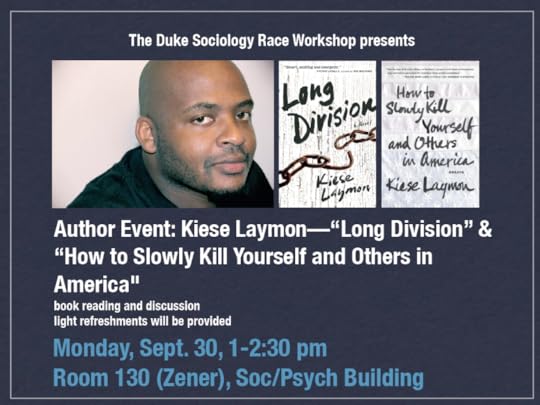Mark Anthony Neal's Blog, page 864
October 1, 2013
Prison Phone Provider Global Tel*Link Profits Off Need to Connect with Incarcerated Loved Ones
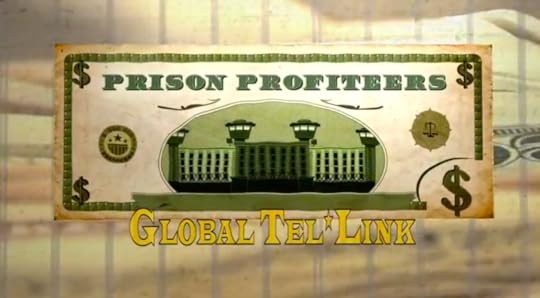 BraveNewFoundation
BraveNewFoundationGlobal Tel*Link profits off love, charging prisoners as much as $17 for a 15-minute phone call. Tell the FCC to set prices families can afford. http://aclu.org/global-tel #prisonprofiteers.
This video is part of the Prison Profiteers series produced in partnership with the ACLU and The Nation. Narration by Henry Rollins. Research help provided by Prison Legal News.
Published on October 01, 2013 19:55
Queer Futures Series: Mark Anthony Neal Talks 'Looking for Leroy' @ Columbia University – October 10th
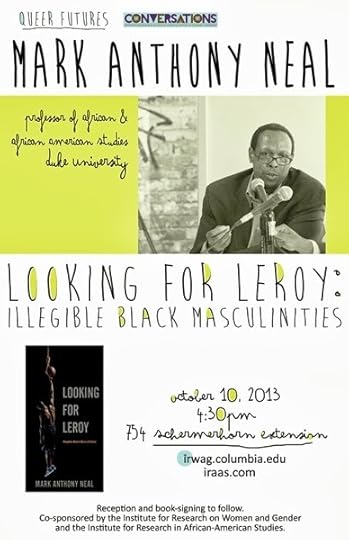
Queer Futures; Mark Anthony Neal on Looking for Leroy: Illegible Black Masculinities
October 10, 2013 – 4:30pm – 6:00pmColumbia University754 Schermerhorn Ext.
On Thursday, October 10, 2013, Professor Mark Anthony Neal will be speaking for IRWAG's Queer Futures series on his book Looking for Leroy: Illegible Black Masculinities.
Looking for Leroy is an analysis of the complex ways in which black masculinity has been read and misread through contemporary American popular culture. Neal argues that black men and boys are bound, in profound ways, to and by their legibility. The most “legible” black male bodies are often rendered as criminal, bodies in need of policing and containment. Ironically, Neal argues, this sort of legibility brings welcome relief to white America, providing easily identifiable images of black men in an era defined by shifts in racial, sexual, and gendered identities.
Mark Anthony Neal is Professor of Black Popular Culture in the Department of African and African-American Studies at Duke University, where he won the 2010 Robert B. Cox Award for Teaching. He is the author of What the Music Said: Black Popular Music and Black Public Culture, Soul Babies: Black Popular Culture and the Post-Soul Aesthetic, Songs in the Keys of Black Life: A Rhythm and Blues Nation, and New Black Man: Rethinking Black Masculinity.
Reception to follow. Copies of Looking forLeroy will be available for purchase.
Published on October 01, 2013 19:01
September 30, 2013
Left of Black S4:E3 | Race, Space & Music in Black and Brown LA w/ Gaye Theresa Johnson
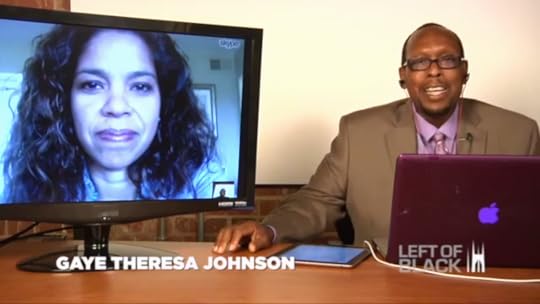 Left of Black S4:E3 | Race, Space & Music in Black and Brown LA w/ Gaye Theresa Johnson
Left of Black S4:E3 | Race, Space & Music in Black and Brown LA w/ Gaye Theresa Johnson
Left of Black host and Duke University Professor Mark Anthony Neal is joined, via Skype, by UC-Santa Barbara Professor Gaye Theresa Johnson, author of Spaces of Conflict, Sounds of Solidarity: Music, Race, and Spatial Entitlement in Los Angeles.
In the book, Johnson examines interracial anti-racist alliances, divisions among aggrieved minority communities, and the cultural expressions and spatial politics that emerge from the mutual struggles of Blacks and Chicanos in Los Angeles from the 1940s to the present.
And stayed tuned for bonus footage with Professor Johnson and a special guest.Left of Black is a weekly Webcast hosted by Mark Anthony Neal and produced in collaboration with the John Hope Franklin Center at Duke University.
***
Episodes of Left of Black are also available for free download in @ iTunes U
***
Follow Gaye Theresa Johnson on Twitter: @LaDoctoraGTJFollow Left of Black on Twitter: @LeftofBlack Follow Mark Anthony Neal on Twitter: @NewBlackMan
Published on September 30, 2013 19:43
Freed by DNA, Angola Prisoner Henry James Reflects on 30 Years Behind Bars
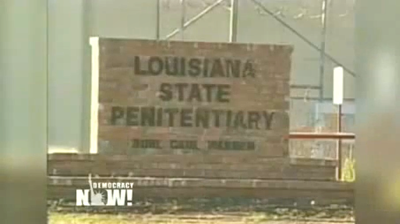 Democracy Now
Democracy NowWe broadcast from New Orleans, Louisiana, the heart of the world's prison capital, where more people are behind bars any other state per capita -- an incarceration rate 13 times that of China. Louisiana also ranks among the highest in the country in terms of the number of people per capita who are exonerated after serving years in prison for crimes they did not commit. We are joined by Henry James, the longest serving prisoner to be exonerated in Louisiana. James spent 30 years in the notorious Louisiana State Penitentiary, known as Angola Prison, on a life sentence without parole for rape. At trial, the prosecution never told the jury that serology testing from the rape kit excluded James as the perpetrator. In 2011, DNA evidence found by accident proved James' innocence, winning him his release.
Published on September 30, 2013 19:15
The Cipher, the Circle & its Wisdom: Toni Blackman at TEDxUMassAmherst
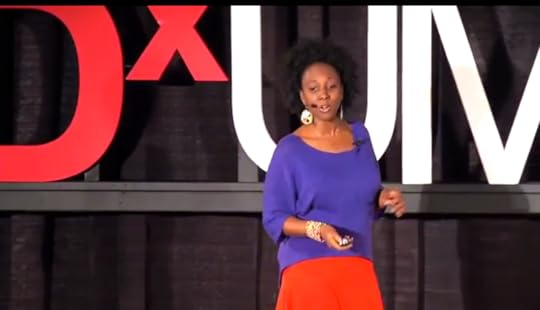 TedxTalks
TedxTalksAward-winning artist, Toni Blackman, selected by U.S. Department of State as the first ever hip-hop ambassador to the United States. In this position, she has served in Senegal, Ghana, Botswana, and Swaziland to host performances, workshops, and lectures on hip-hop music and culture. She is also the founder and director of Freestyle Union, a cipher workshop that uses free styling as a tool to encourage social responsibility. She also is as a member of the Spoken Word Committee of the Grammy's decision board, New York Chapter.
Published on September 30, 2013 08:02
'Let the Fire Burn': New Film Documents the MOVE 9
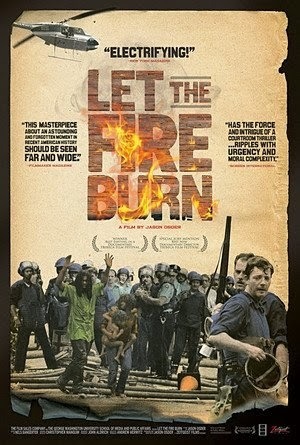 ‘Let The Fire Burn’: New Film Documents the MOVE 9
by Lamont Lilly | special to NewBlackMan (in Exile)
‘Let The Fire Burn’: New Film Documents the MOVE 9
by Lamont Lilly | special to NewBlackMan (in Exile)On Friday, September 20th2013, the Full Frame Theatre in Durham, NC hosted the premiere of a film called Let The Fire Burn by filmmaker and director, Jason Osder. It was supposed to premiere during the Full Frame Film Festival in April, but had to postpone its Durham debut until Full Frame’s Third Friday Free Film Series. For those of us who attended, it worked out perfectly. It was a packed house as no seat went unfilled for the 7:30pm screening. Little did we know, Durham was about to view the Philadelphia Police Department’s most heinous act of brutality in the city’s history.
Let The Fire Burn is a documentary about the bombing of an organization called MOVE and historical developments concerning the group’s political repression by the city of Philadelphia since 1978. Osder’s premiere of Let The Fire Burn was absolutely riveting.
Founded by John Africa in 1972, MOVE (originally, “Christian Movement for Life”) was a small group of Black Liberationists who prescribed to a strict cultural and religious philosophy. As detailed in Osder’s new film, from the initial stages of MOVE’s conception the Philadelphia police began keeping tabs on the group’s teachings and community activities.
 Prior to the film’s core storyline of the 1985 bombing, Let The Fire Burndetails the Philadelphia Police Department’s 1978 raid on MOVE’s Powelton Village home in West Philadelphia. Osder’s new documentary also shares the story of the MOVE 9, members of the organization who have currently been in prison for 35 years, some say on trumped up charges. Carefully cut, the footage is raw and very intense, penetrating the pores of struggle from the front row. Much of this modern day atrocity was captured on television and news circuits live. In addition to personal interviews, the bulk of Osder’s documentary is compiled from archival broadcasting. Osder was also able to gather home videos captured by community residents who were present at both raids. As Let The Fire Burn journeys from one decade to the next, viewers never lose a beat.
Prior to the film’s core storyline of the 1985 bombing, Let The Fire Burndetails the Philadelphia Police Department’s 1978 raid on MOVE’s Powelton Village home in West Philadelphia. Osder’s new documentary also shares the story of the MOVE 9, members of the organization who have currently been in prison for 35 years, some say on trumped up charges. Carefully cut, the footage is raw and very intense, penetrating the pores of struggle from the front row. Much of this modern day atrocity was captured on television and news circuits live. In addition to personal interviews, the bulk of Osder’s documentary is compiled from archival broadcasting. Osder was also able to gather home videos captured by community residents who were present at both raids. As Let The Fire Burn journeys from one decade to the next, viewers never lose a beat.On August 8th 1978, the Philadelphia Police Department raided MOVE’s communal residence in Powelton Village on grounds of “conspiracy and suspicious activity.” During the raid, Philadelphia police officer, James Ramp was somehow shot and killed. Ballistics and state evidence pointed to friendly fire. Yet, nine MOVE members were convicted of the murder of one cop and sentenced to 30 to 100 years in federal prison. The sentencing judge would later admit that he had no idea who fired the fatal bullet. The few guns that were seized from MOVE’s home were later found to be inoperative by state investigators. Two days later, their Powelton Village home (along with critical evidence) was destroyed by city bulldozers as the group was forced to relocate.
 Osder’s visual lens then takes you to the year 1985 to MOVE’s new address on 6221 Osage Ave. The group’s new location was in a quiet and cozy section of Philadelphia’s black working class district called Cobbs Creek. MOVE’s alternative lifestyle was a severe contrast to the neighborhood’s accepted norms and values. Complaints from neighbors reported profanity projected through loudspeakers, children exposed publicly nude, and vast amounts of unwanted varmints. Piles of compost and human waste also created disdain. In all fairness, MOVE members were also advocates of religious freedom, animal rights, gender equality and racial solidarity. Life and love were the cornerstones of the group’s existence. Nevertheless, the Philadelphia Police Department leveraged those concerns to wage war. Publicly, the decision to raid the group’s new location was to “clean up the building and arrest members who had outstanding warrants.” As Let The Fire Burn so vividly depicts, the Philadelphia Police Department’s assault on May 13th 1985, would mark an American tragedy.
Osder’s visual lens then takes you to the year 1985 to MOVE’s new address on 6221 Osage Ave. The group’s new location was in a quiet and cozy section of Philadelphia’s black working class district called Cobbs Creek. MOVE’s alternative lifestyle was a severe contrast to the neighborhood’s accepted norms and values. Complaints from neighbors reported profanity projected through loudspeakers, children exposed publicly nude, and vast amounts of unwanted varmints. Piles of compost and human waste also created disdain. In all fairness, MOVE members were also advocates of religious freedom, animal rights, gender equality and racial solidarity. Life and love were the cornerstones of the group’s existence. Nevertheless, the Philadelphia Police Department leveraged those concerns to wage war. Publicly, the decision to raid the group’s new location was to “clean up the building and arrest members who had outstanding warrants.” As Let The Fire Burn so vividly depicts, the Philadelphia Police Department’s assault on May 13th 1985, would mark an American tragedy.That was the day over 200 Philadelphia police officers gathered outside of MOVE’s home on Osage Ave. That was the day over 10,000 rounds of police ammunition was used against unarmed citizens. Officers claimed they were fearful of MOVE’s massive collection of firearms and explosives. Yet, no automatic weapons were found in MOVE’s residence. Initially, officers deployed tear gas through broken windows. Then water, lots of it. One thousand gallons of water per minute were dispersed via the Philadelphia Fire Department from the roof and sides of the house. MOVE children were taken downstairs to the basement in search of safety. SWAT and Tactical Teams swarmed to exits like bees to warm honey. Supposedly, they were guarding against MOVE members trying to escape. Philadelphia police actually admitted to firing so much, they depleted their supply of bullets.
All of a sudden a bomb was dropped on MOVE’s roof from a police helicopter. Four pounds of C4 explosives were dropped on a row house full of people. Minutes later, another bomb was dropped. When informed about the developments of this violent occurrence, Philadelphia’s African American Mayor, Wilson Goode consciously responded on live video to “Just let the fire burn.” The water hoses that were once pumping thousands of gallons of water per minute were turned off. A raging fire that had already killed 11 people was intentionally allowed to spread. At first, it was the homes on MOVE’s immediate left and right that caught blaze. In just a few brief hours, 61 homes had been completely destroyed—memories and life-savings leveled to worthless ashes. Worst of all, Mayor Goode watched the destruction from his office television at City Hall.
Only two MOVE survivors exited the burning building – activist, Ramona Africa and a young boy named Birdie, whose testimony and childhood descriptions were documented throughout the film. The one officer who ran to safe Birdie and Ramona quit the Philadelphia Police Department in 1987. After his heroic feat, he was branded a ‘nigger lover’ by fellow officers and ostracized from the force.

Interestingly, after the state-sponsored murder of 11 people, Mayor Wilson Goode appointed an investigative commission. On March 6th 1986, the MOVE commission released their report publicly, denouncing the actions and poor decisions of city officials. The commission reported that “dropping a bomb on an occupied row house was unconscionable.” However, in lieu of such formal denouncement, not one city official, police officer or fireman was ever held accountable. Osder’s Let The Fire Burn shows live hearings from the MOVE commission, public testimonies and the commission’s ruling verdict.
Sitting in the audience, I couldn’t believe what I was seeing. The Full Frame Theatre was pin drop quiet. In 95 minutes, Osder’s documentary captures this entire saga, plus more. The fabric in which Osder weaves this story is almost a little too real. Leaving the theatre you felt like you were actually there in 1985. Much of that surreal experience is the result of live coverage. Local news channels were covering the entire event. Much of the film’s footage was cut and clipped from on-the-ground sources present that day. Nels Bangeter was the film’s chief editor, a role quite critical when considering there wasn’t much originally created or produced, here. Limiting praise to filmmaker and director, Jason Osder would be like only crediting Kanye West for the classic sample he sliced. Osder and Bangeter were a perfect pairing for this project.
Let The Fire Burn took Jason Osder over 10 years to make. And that’s exactly how it looks, meticulous, time-consuming and well crafted. Osder’s eye sculpts the film seamlessly on a tightrope of truth without bias. During the post Q&A he discussed how most media sources demonized the organization, referring to MOVE as terrorists. Yet, he saw them as human beings who had caught an “extremely raw deal of injustice.” Osder grew up in Philadelphia, stating that “The timing of it dawned on my conscience even as a small child. It was the moment that cracked my childhood shell.”As for MOVE, this film isn’t just a movie—it’s real lives that are painfully still playing out. Eight of the original MOVE 9 members have been in prison for 35 years now. Merle Africa died while incarcerated in 1998. In 1996, federal courts mandated the city of Philadelphia to pay out $1.5 million to one of the survivors and relatives of two members who were killed in the 1985 bombing. The jury concluded that local law enforcement and city officials violated the organization’s constitutional rights under “unreasonable search and seizure.” In 2008, the late Howard Zinn wrote a formal letter to the Pennsylvania Board of Probation and Parole in support of the MOVE 9’s immediate release. Author, activist, and political prisoner, Mumia Abu Jamal has always testified to the state repression of MOVE. Pam and Ramona Africa have traveled all over the nation raising awareness.
As Let The Fire Burn clearly illustrates, justice is still waiting in this case. Truth is still waiting to be unleashed. Take a bow Jason Osder; you’ve done well. Every American should see this film. And every Black person should own it.
▪▪▪
[Special Note: Birdie Africa (Michael Ward) recently died Friday, September 20th2013, eerily on the same night of Let The Fire Burn’s Full Frame debut. He mysteriously drowned in a hot tub of a Carnival cruise ship in the Caribbean. The Medical Examiner’s Office is expecting six to eight weeks before toxicology tests return. Birdie’s untimely death marks another sad ending to an American tragedy.]
Lamont Lilly is a contributing editor with the Triangle Free Press, Human Rights Delegate with Witness for Peace and organizer with Workers World Party. Follow him on Twitter @LamontLilly. He resides in Durham, NC.
Published on September 30, 2013 07:05
September 28, 2013
Gaye Theresa Johnson Talks About Music, Race & Space in LA on the September 30th 'Left of Black'
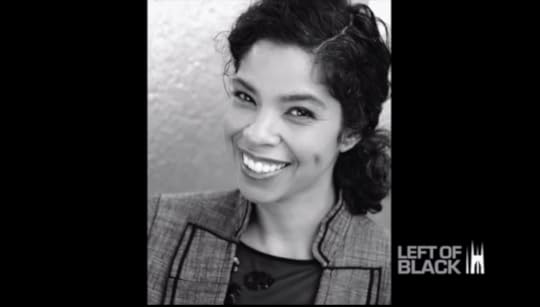 FranklinCenteratDuke (@JHFCenter)
FranklinCenteratDuke (@JHFCenter)Professor Gaye Theresa Johnson (@LaDoctoraGTJ), author of Spaces of Conflict, Sounds of Solidarity: Music, Race, and Spatial Entitlement in Los Angeles , will join Mark Anthony Neal (@NewBlackMan) on Left of Black (@LeftofBlack) Monday, Sept. 30th.
Professor Johnson is a faculty member in the Department of Black Studies with affiliations in the Departments of History and Chicana/o Studies at the University of California at Santa Barbara.
Published on September 28, 2013 07:03
September 27, 2013
A Walk-Thru of Photo Journalist Mia Gröndahl's Exhibit 'Revolution Graffiti: Street Art of Egypt'
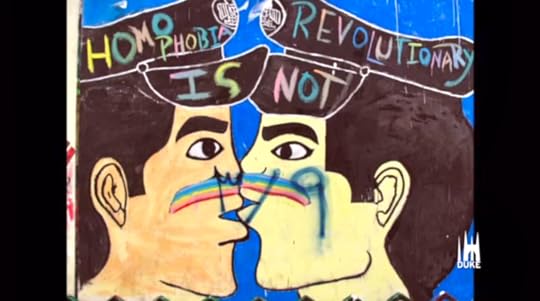 FranklinCenteratDuke
FranklinCenteratDukeMia Gröndahl is a Swedish photo journalist based in Cairo. Over the last two years, Gröndahl documented the graffiti movement of Egypt. Gröndahl's work has been published by the American University in Cairo in a book titled, Revolution Graffiti: Street Art of the New Egypt . Selections from Gröndahl's collection of photos are on display at the John Hope Franklin Center Gallery between September 16 - November 22, 2013.
Mia Gröndahl's exhibit was brought to Duke University by Duke University Middle East Studies Center, Center for Global Studies and the Humanities, Duke Human Rights Center at the Franklin Humanities Institute (DHRC@FHI), Duke Islamic Studies Center, and John Hope Franklin Center (JHFC).
Video tour produced by Julie Poucher Harbin, editor, ISLAMiCommentary and staff at the John Hope Franklin Center.
Published on September 27, 2013 20:11
Syleena Johnson And Musiq Soulchild on Making Music In Nine Days
Published on September 27, 2013 19:45
Kiese Laymon 'Shows His Work' at Duke University on September 30th
Published on September 27, 2013 14:49
Mark Anthony Neal's Blog
- Mark Anthony Neal's profile
- 30 followers
Mark Anthony Neal isn't a Goodreads Author
(yet),
but they
do have a blog,
so here are some recent posts imported from
their feed.



